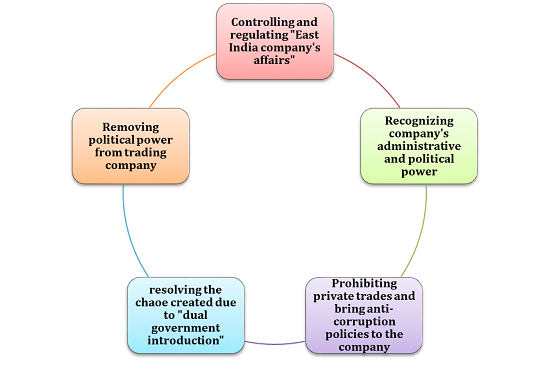

In the year 1773, the Regulating Act was mainly introduced to form an administrative system as the central part of British India. The East India Company required some operational changes. The act was introduced not to take full control but to regulate various activities of the company
The Regulating Act was an act introduced by the British Parliament. It was passed for controlling major territories of Bengal under the East India Company. The company faced financial issues at a very high level by 1773. The trading firm was constituted in a monopolistic manner as a result the company reached a bankrupt situation and the British government needed to depend on other affairs of the company. The corporation had to pay around forty thousand euros for maintaining a monopoly market but it failed to meet its needs since 1768. America’s tea shipment was decreased, leading to the smuggling of teas cartons

Figure 1: Goals of Regulating Act, 1773
The company had debts to the governments and banks. Tea in Britain's storage decayed about fifteen million pounds. Tea was progressively imported from India. In 1773, the Regulating Act was implemented as a complementary form of the Tea Act. The goal was to reduce to tea amount from the British East India Company’s London storage and shift to the corporation that is suffering financially.
The act was passed due to the following reasons.
The financial situation of the East India Company in the year 1772 reached an extreme crisis level. The loan was about one million pounds from the government of Britain.
The officials of the company were alligated for nepotism and corruption.
Bengal’s population collapsed by a huge amount due to a terrible famine. Also, there was increased corruption.
Another reason for this act is Robert Clive's dual administration. There were numerous complaints about this complex system. In Bengal, the company had the rights of Diwani. Nizamat rights were acquired by Nawabs from the Meghal era. The ultimate power although was with the company. The company's goal was only to increase its profit and the sufferings of common individuals including the farmers were neglected.
Hyder Ali defeated the company in 1769 causing a threat to the company.
The act enabled the company to keep its Indian territories alive. The company functions and activities continued to regulate. It was regulated as the power was not withdrawn completely.
4 councillors and a General Governor were appointed in Fort William’s presidency in Calcutta.
The Governor-General’s post was given to Warren Hastings.
Bombay and Madras’s Governors in Councils were also taken under Bengal’s control. Foreign policies were emphasized in this situation. This system prohibited other states to fight without approval from Bengal.
Indian authorities’ revenue, military and civil matters and related documents were asked to be presented by the company directors to the British authorities.
The establishment of a supreme court for judiciary matters occurred In Calcutta and Sir Elijah Impey pointed as the Chief Justice. It was for criminal and civil jurisdiction for subjects related to Britain and not for natives of India.
The act was significant for the judiciary and other matters.
The act presented a judiciary structure change. A landmark was pointed out with the country’s judiciary structure alteration in a dynamic way.
Court of Directors or COD got some important changes Constitutionally with the release of this act.
East India Company’s administrative and political functions were recognized for the first time.
This act established the central administration in the country as a foundation step.
The initial establishment of Calcutta’s supreme court was done with the act by bringing judges from England. This introduced the judiciary system in proper order and its extent was also regulated.
There were some faults in this act.
There was a lack of veto authority. It was needed for the Governor General.
Corruption by the company officials had continued and the Regulating Act did not affect it.
Indian customers who had invested money in the organization were unhappy as their complaints were not entertained by this act.
The authority of The Supreme Court was not evident. There were complexities in the operations.
The Governor-General appointed in the Cabinet supplied reports but these were not examined properly. The company operation was not as effective as it was needed in case of legislative oversight.
The Regulating Act was an operational act introduced in 1773 by the British government to reduce debt. The act was implemented for the East India Company. The judiciary system of India was majorly changed with the introduction of The Supreme court in Calcutta. The company directors and other operational bodies were elected for a certain period. The Act was beneficial for the company and not for Indian citizens. There were operational defects in the judiciary process. The regulating Act was only for emphasizing British rules in India.
Q1. What were the restrictions of the Regulating Act?
1773’s Regulating Act introduced by Great Britain's parliament made restrictions on the dividends of the company by 6%. It limited the Court of Directors with terms of four years. Company employees could not accept any bribery or gift from natives and also any personal trade was not possible.
Q2. When was the Regulating Act published?
The Regulating Act, 1773 was published on the 10th of June, 1773. It was introduced initially by Lord North and Frederick North on 18th May of the same year.
Q3. Why did the Regulating Act fail?
The Regulating Act was not helpful in any way for the Indians who sourced the revenue. The veto power was not for the Governor-general. The corruption continued by company officials.